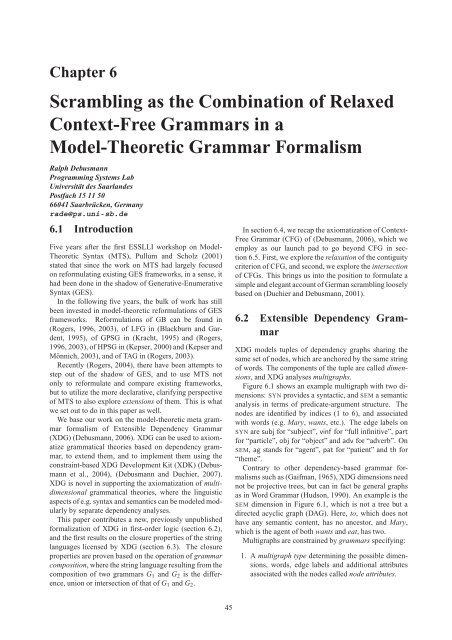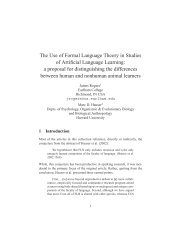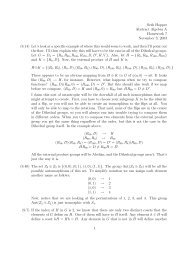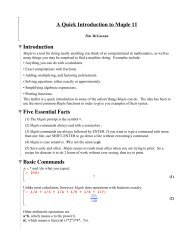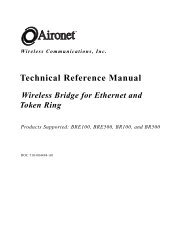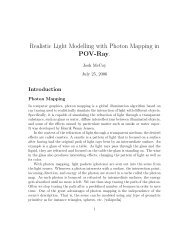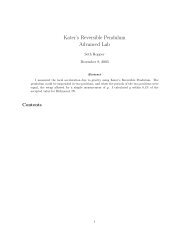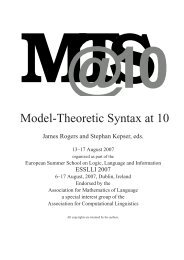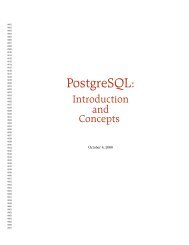Scrambling as the Combination of Relaxed Context-Free Grammars in
Scrambling as the Combination of Relaxed Context-Free Grammars in
Scrambling as the Combination of Relaxed Context-Free Grammars in
Create successful ePaper yourself
Turn your PDF publications into a flip-book with our unique Google optimized e-Paper software.
Chapter 6<br />
<strong>Scrambl<strong>in</strong>g</strong> <strong>as</strong> <strong>the</strong> <strong>Comb<strong>in</strong>ation</strong> <strong>of</strong> <strong>Relaxed</strong><br />
<strong>Context</strong>-<strong>Free</strong> <strong>Grammars</strong> <strong>in</strong> a<br />
Model-Theoretic Grammar Formalism<br />
Ralph Debusmann<br />
Programm<strong>in</strong>g Systems Lab<br />
Universität des Saarlandes<br />
Postfach 15 11 50<br />
66041 Saarbrücken, Germany<br />
rade@ps.uni-sb.de<br />
6.1 Introduction<br />
Five years after <strong>the</strong> first ESSLLI workshop on Model-<br />
Theoretic Syntax (MTS), Pullum and Scholz (2001)<br />
stated that s<strong>in</strong>ce <strong>the</strong> work on MTS had largely focused<br />
on reformulat<strong>in</strong>g exist<strong>in</strong>g GES frameworks, <strong>in</strong> a sense, it<br />
had been done <strong>in</strong> <strong>the</strong> shadow <strong>of</strong> Generative-Enumerative<br />
Syntax (GES).<br />
In <strong>the</strong> follow<strong>in</strong>g five years, <strong>the</strong> bulk <strong>of</strong> work h<strong>as</strong> still<br />
been <strong>in</strong>vested <strong>in</strong> model-<strong>the</strong>oretic reformulations <strong>of</strong> GES<br />
frameworks. Reformulations <strong>of</strong> GB can be found <strong>in</strong><br />
(Rogers, 1996, 2003), <strong>of</strong> LFG <strong>in</strong> (Blackburn and Gardent,<br />
1995), <strong>of</strong> GPSG <strong>in</strong> (Kracht, 1995) and (Rogers,<br />
1996, 2003), <strong>of</strong> HPSG <strong>in</strong> (Kepser, 2000) and (Kepser and<br />
Mönnich, 2003), and <strong>of</strong> TAG <strong>in</strong> (Rogers, 2003).<br />
Recently (Rogers, 2004), <strong>the</strong>re have been attempts to<br />
step out <strong>of</strong> <strong>the</strong> shadow <strong>of</strong> GES, and to use MTS not<br />
only to reformulate and compare exist<strong>in</strong>g frameworks,<br />
but to utilize <strong>the</strong> more declarative, clarify<strong>in</strong>g perspective<br />
<strong>of</strong> MTS to also explore extensions <strong>of</strong> <strong>the</strong>m. This is what<br />
we set out to do <strong>in</strong> this paper <strong>as</strong> well.<br />
We b<strong>as</strong>e our work on <strong>the</strong> model-<strong>the</strong>oretic meta grammar<br />
formalism <strong>of</strong> Extensible Dependency Grammar<br />
(XDG) (Debusmann, 2006). XDG can be used to axiomatize<br />
grammatical <strong>the</strong>ories b<strong>as</strong>ed on dependency grammar,<br />
to extend <strong>the</strong>m, and to implement <strong>the</strong>m us<strong>in</strong>g <strong>the</strong><br />
constra<strong>in</strong>t-b<strong>as</strong>ed XDG Development Kit (XDK) (Debusmann<br />
et al., 2004), (Debusmann and Duchier, 2007).<br />
XDG is novel <strong>in</strong> support<strong>in</strong>g <strong>the</strong> axiomatization <strong>of</strong> multidimensional<br />
grammatical <strong>the</strong>ories, where <strong>the</strong> l<strong>in</strong>guistic<br />
<strong>as</strong>pects <strong>of</strong> e.g. syntax and semantics can be modeled modularly<br />
by separate dependency analyses.<br />
This paper contributes a new, previously unpublished<br />
formalization <strong>of</strong> XDG <strong>in</strong> first-order logic (section 6.2),<br />
and <strong>the</strong> first results on <strong>the</strong> closure properties <strong>of</strong> <strong>the</strong> str<strong>in</strong>g<br />
languages licensed by XDG (section 6.3). The closure<br />
properties are proven b<strong>as</strong>ed on <strong>the</strong> operation <strong>of</strong> grammar<br />
composition, where <strong>the</strong> str<strong>in</strong>g language result<strong>in</strong>g from <strong>the</strong><br />
composition <strong>of</strong> two grammars G 1 and G 2 is <strong>the</strong> difference,<br />
union or <strong>in</strong>tersection <strong>of</strong> that <strong>of</strong> G 1 and G 2 .<br />
In section 6.4, we recap <strong>the</strong> axiomatization <strong>of</strong> <strong>Context</strong>-<br />
<strong>Free</strong> Grammar (CFG) <strong>of</strong> (Debusmann, 2006), which we<br />
employ <strong>as</strong> our launch pad to go beyond CFG <strong>in</strong> section<br />
6.5. First, we explore <strong>the</strong> relaxation <strong>of</strong> <strong>the</strong> contiguity<br />
criterion <strong>of</strong> CFG, and second, we explore <strong>the</strong> <strong>in</strong>tersection<br />
<strong>of</strong> CFGs. This br<strong>in</strong>gs us <strong>in</strong>to <strong>the</strong> position to formulate a<br />
simple and elegant account <strong>of</strong> German scrambl<strong>in</strong>g loosely<br />
b<strong>as</strong>ed on (Duchier and Debusmann, 2001).<br />
6.2 Extensible Dependency Grammar<br />
XDG models tuples <strong>of</strong> dependency graphs shar<strong>in</strong>g <strong>the</strong><br />
same set <strong>of</strong> nodes, which are anchored by <strong>the</strong> same str<strong>in</strong>g<br />
<strong>of</strong> words. The components <strong>of</strong> <strong>the</strong> tuple are called dimensions,<br />
and XDG analyses multigraphs.<br />
Figure 6.1 shows an example multigraph with two dimensions:<br />
SYN provides a syntactic, and SEM a semantic<br />
analysis <strong>in</strong> terms <strong>of</strong> predicate-argument structure. The<br />
nodes are identified by <strong>in</strong>dices (1 to 6), and <strong>as</strong>sociated<br />
with words (e.g. Mary, wants, etc.). The edge labels on<br />
SYN are subj for “subject”, v<strong>in</strong>f for “full <strong>in</strong>f<strong>in</strong>itive”, part<br />
for “particle”, obj for “object” and adv for “adverb”. On<br />
SEM, ag stands for “agent”, pat for “patient” and th for<br />
“<strong>the</strong>me”.<br />
Contrary to o<strong>the</strong>r dependency-b<strong>as</strong>ed grammar formalisms<br />
such <strong>as</strong> (Gaifman, 1965), XDG dimensions need<br />
not be projective trees, but can <strong>in</strong> fact be general graphs<br />
<strong>as</strong> <strong>in</strong> Word Grammar (Hudson, 1990). An example is <strong>the</strong><br />
SEM dimension <strong>in</strong> Figure 6.1, which is not a tree but a<br />
directed acyclic graph (DAG). Here, to, which does not<br />
have any semantic content, h<strong>as</strong> no ancestor, and Mary,<br />
which is <strong>the</strong> agent <strong>of</strong> both wants and eat, h<strong>as</strong> two.<br />
Multigraphs are constra<strong>in</strong>ed by grammars specify<strong>in</strong>g:<br />
1. A multigraph type determ<strong>in</strong><strong>in</strong>g <strong>the</strong> possible dimensions,<br />
words, edge labels and additional attributes<br />
<strong>as</strong>sociated with <strong>the</strong> nodes called node attributes.<br />
45
46 <strong>Scrambl<strong>in</strong>g</strong> <strong>as</strong> <strong>the</strong> <strong>Comb<strong>in</strong>ation</strong> <strong>of</strong> <strong>Relaxed</strong> <strong>Context</strong>-<strong>Free</strong> <strong>Grammars</strong> <strong>in</strong> a Model-Theoretic Grammar Formalism<br />
SYN:<br />
subj<br />
v<strong>in</strong>f<br />
adv<br />
SYN:<br />
v<strong>in</strong>f<br />
part<br />
obj<br />
1<br />
2<br />
3<br />
4 5<br />
6<br />
part!<br />
obj<br />
adv*<br />
Mary<br />
SEM:<br />
ag<br />
wants<br />
ag<br />
to<br />
th<br />
eat spaghetti<br />
th<br />
pat<br />
today<br />
SEM:<br />
part <<br />
th*<br />
eat<br />
↓<br />
< obj < adv<br />
1<br />
Mary<br />
2<br />
wants<br />
3<br />
to<br />
4 5<br />
eat spaghetti<br />
6<br />
today<br />
ag!<br />
(subj)<br />
eat<br />
pat<br />
(obj)<br />
Figure 6.1: XDG multigraph for Mary wants to eat<br />
spaghetti today.<br />
Figure 6.2: Lexical entry for <strong>the</strong> word eat<br />
2. A lexicon determ<strong>in</strong><strong>in</strong>g a subset <strong>of</strong> <strong>the</strong> node attributes<br />
<strong>of</strong> each node, depend<strong>in</strong>g on <strong>the</strong> <strong>as</strong>sociated word.<br />
3. A set <strong>of</strong> pr<strong>in</strong>ciples stipulat<strong>in</strong>g <strong>the</strong> well-formedness<br />
conditions <strong>of</strong> <strong>the</strong> multigraphs.<br />
XDG is a meta grammar formalism. Instances <strong>of</strong> XDG<br />
are def<strong>in</strong>ed by fix<strong>in</strong>g a multigraph type and a set <strong>of</strong> pr<strong>in</strong>ciples,<br />
and leav<strong>in</strong>g <strong>the</strong> lexicon variable.<br />
XDG pr<strong>in</strong>ciples stipulate e.g. treeness, DAG-ness, projectivity,<br />
valency and order constra<strong>in</strong>ts. They can also<br />
constra<strong>in</strong> <strong>the</strong> relation <strong>of</strong> multiple dimensions, which is<br />
used e.g. <strong>in</strong> <strong>the</strong> l<strong>in</strong>k<strong>in</strong>g pr<strong>in</strong>ciple to constra<strong>in</strong> <strong>the</strong> relation<br />
between arguments on SEM and <strong>the</strong>ir syntactic realization<br />
on SYN. Some pr<strong>in</strong>ciples are lexicalized, i.e., <strong>the</strong>y<br />
constra<strong>in</strong> <strong>the</strong> analysis with respect to <strong>the</strong> lexicon.<br />
The lexicon constra<strong>in</strong>s all dimensions simultaneously,<br />
and <strong>the</strong>reby synchronizes <strong>the</strong>m. Figure 6.2 depicts an example<br />
graphical lexical entry for <strong>the</strong> word eat. On SYN,<br />
by <strong>the</strong> lexicalized valency pr<strong>in</strong>ciple, <strong>the</strong> lexical entry licenses<br />
zero or one <strong>in</strong>com<strong>in</strong>g edges labeled v<strong>in</strong>f, precisely<br />
one part, zero or one obj, arbitrary many adv dependents,<br />
and no o<strong>the</strong>r <strong>in</strong>com<strong>in</strong>g and outgo<strong>in</strong>g edges. By <strong>the</strong> order<br />
pr<strong>in</strong>ciple, <strong>the</strong> part dependents must precede <strong>the</strong> head<br />
eat, which must precede <strong>the</strong> obj and <strong>the</strong> adv dependents.<br />
On SEM, <strong>the</strong> lexical entry licenses arbitrary many <strong>in</strong>com<strong>in</strong>g<br />
th edges, and requires precisely one ag dependent and<br />
zero or one pat dependents (valency pr<strong>in</strong>ciple). It licenses<br />
no o<strong>the</strong>r <strong>in</strong>com<strong>in</strong>g and outgo<strong>in</strong>g edges. The patient must<br />
be realized by <strong>the</strong> object (l<strong>in</strong>k<strong>in</strong>g pr<strong>in</strong>ciple). The realization<br />
<strong>of</strong> <strong>the</strong> agent is not constra<strong>in</strong>ed.<br />
6.2.1 Multigraph<br />
We turn to <strong>the</strong> formalization <strong>of</strong> XDG. Contrary to (Debusmann,<br />
2006), which is higher-order, our formalization<br />
is first-order, and hence called FO XDG. We beg<strong>in</strong> with<br />
multigraphs. Multigraphs are formulated over <strong>the</strong> labeled<br />
dom<strong>in</strong>ance relation. This corresponds to <strong>the</strong> transitive<br />
closure <strong>of</strong> <strong>the</strong> labeled edge relation, where <strong>the</strong> label is <strong>the</strong><br />
label <strong>of</strong> <strong>the</strong> first edge. The purpose <strong>of</strong> <strong>in</strong>clud<strong>in</strong>g this relation<br />
and not <strong>the</strong> labeled edge relation itself is to stay <strong>in</strong><br />
first-order logic: if we <strong>in</strong>cluded only <strong>the</strong> labeled edge relation,<br />
we could not express <strong>the</strong> transitive closure without<br />
extend<strong>in</strong>g <strong>the</strong> logic with fixpo<strong>in</strong>ts or second-order quantification.<br />
Def<strong>in</strong>ition 6.2.1 (Multigraph). Given a f<strong>in</strong>ite set <strong>of</strong> dimensions<br />
D, a f<strong>in</strong>ite set <strong>of</strong> words W , a f<strong>in</strong>ite set <strong>of</strong> edge<br />
labels L, a f<strong>in</strong>ite set <strong>of</strong> attributes A, and a f<strong>in</strong>ite set <strong>of</strong><br />
set types T , a multigraph M = (V,E + ,
Ralph Debusmann 47<br />
Def<strong>in</strong>ition 6.2.4 (Multigraph <strong>of</strong> Multigraph Type). A<br />
multigraph M = (V,E + ,
48 <strong>Scrambl<strong>in</strong>g</strong> <strong>as</strong> <strong>the</strong> <strong>Comb<strong>in</strong>ation</strong> <strong>of</strong> <strong>Relaxed</strong> <strong>Context</strong>-<strong>Free</strong> <strong>Grammars</strong> <strong>in</strong> a Model-Theoretic Grammar Formalism<br />
2. fixed recognition problem (FRP): G is fixed and s is<br />
variable<br />
3. <strong>in</strong>stance recognition problem (IRP): <strong>the</strong> pr<strong>in</strong>ciples<br />
are fixed, and <strong>the</strong> lexicon and s are variable<br />
In (Debusmann, 2007), we prove us<strong>in</strong>g results from<br />
(Vardi, 1982), that <strong>the</strong> URP is PSPACE-complete, <strong>the</strong><br />
FRP and IRP are NP-complete.<br />
6.2.6 Example Pr<strong>in</strong>ciples<br />
We present a number <strong>of</strong> illustrative example pr<strong>in</strong>ciples.<br />
For generality, <strong>the</strong> pr<strong>in</strong>ciples are parametrized by <strong>the</strong> dimensions<br />
that <strong>the</strong>y constra<strong>in</strong>.<br />
Tree pr<strong>in</strong>ciple. Given a dimension d, <strong>the</strong> tree pr<strong>in</strong>ciple<br />
stipulates that 1) <strong>the</strong>re must be no cycles, 2) <strong>the</strong>re<br />
is precisely one node without a mo<strong>the</strong>r (<strong>the</strong> root), 3) all<br />
nodes have zero or one mo<strong>the</strong>rs, and 4) <strong>the</strong>re cannot be<br />
two edges between mo<strong>the</strong>r and daughter:<br />
tree d =<br />
∀v : ¬(v→ + d v) ∧<br />
∃!v : ¬∃v ′ : v ′ → d<br />
v ∧<br />
∀v : (¬∃v ′ : v ′ → d<br />
v) ∨(∃!v ′ : v ′ → d<br />
v) ∧<br />
l<br />
∀v : ∀v ′ : ∀l : v−→ d v ′ ⇒ (∀l ′ : v−→ l′<br />
d v ′ ⇒ l = l ′ )<br />
Projectivity pr<strong>in</strong>ciple. Given a dimension d, <strong>the</strong> projectivity<br />
pr<strong>in</strong>ciple forbids cross<strong>in</strong>g edges by stipulat<strong>in</strong>g<br />
that all nodes positioned between a head and a dependent<br />
must be below <strong>the</strong> head.<br />
projectivity d =<br />
∀v,v ′ :<br />
(v→ d<br />
v ′ ∧ v < v ′ ⇒ ∀v ′′ : v < v ′′ ∧ v ′′ < v ′ ⇒ v→ + d v′′ ) ∧<br />
(v→ d<br />
v ′ ∧ v ′ < v ⇒ ∀v ′′ : v ′ < v ′′ ∧ v ′′ < v ⇒ v→ + d v′′ )<br />
For example, this pr<strong>in</strong>ciple is violated on <strong>the</strong> SEM dimension<br />
<strong>in</strong> Figure 6.1, where wants is positioned between eat<br />
and Mary, but is not below eat.<br />
To expla<strong>in</strong> <strong>the</strong> lexicalized valency, order and l<strong>in</strong>k<strong>in</strong>g<br />
pr<strong>in</strong>ciples, we show an example concrete lexical entry for<br />
eat <strong>in</strong> Figure 6.3, model<strong>in</strong>g <strong>the</strong> graphical lexical entry <strong>in</strong><br />
Figure 6.2.<br />
Valency pr<strong>in</strong>ciple. Given a dimension d, <strong>the</strong> valency<br />
pr<strong>in</strong>ciple constra<strong>in</strong>s <strong>the</strong> <strong>in</strong>com<strong>in</strong>g and outgo<strong>in</strong>g edges <strong>of</strong><br />
each node accord<strong>in</strong>g to <strong>the</strong> lexical attributes <strong>in</strong> and out <strong>of</strong><br />
type 2 (dl d)×{!,+,,∗} , which models <strong>the</strong> function (dl d) →<br />
{!,+,,∗} from edge labels on d to card<strong>in</strong>alities, where<br />
! stands for “one”, + for “more than one”, for “zero or<br />
one”, and ∗ for “arbitrary many”.<br />
valency d =<br />
∀v : ∀l :<br />
((l,!) ∈ (d v).<strong>in</strong> ⇒ ∃!v ′ : v ′ −→ d v) ∧<br />
((l,+) ∈ (d v).<strong>in</strong> ⇒ ∃v ′ : v ′ −→ d v) ∧<br />
l<br />
l<br />
((l,) ∈ (d v).<strong>in</strong> ⇒ ¬∃v ′ : v ′ −→ d v ∨ ∃!v ′ : v ′ −→ d v) ∧<br />
(¬(l,!) ∈ (d v).<strong>in</strong> ∧ ¬(l,+) ∈ (d v).<strong>in</strong> ∧ ¬(l,) ∈ (d v).<strong>in</strong> ∧<br />
¬(l,∗) ∈ (d v).<strong>in</strong> ⇒ ¬∃v ′ : v ′ −→ d v) ∧<br />
((l,!) ∈ (d v).out ⇒ ∃!v ′ : v−→ d v ′ ) ∧<br />
...<br />
l<br />
l<br />
l<br />
l<br />
The rema<strong>in</strong><strong>in</strong>g part <strong>of</strong> <strong>the</strong> pr<strong>in</strong>ciple deal<strong>in</strong>g with <strong>the</strong> outgo<strong>in</strong>g<br />
edges proceeds analogously. Given <strong>the</strong> concrete<br />
lexical entry <strong>in</strong> Figure 6.3, <strong>the</strong> pr<strong>in</strong>ciple constra<strong>in</strong>s node<br />
eat on SYN such that <strong>the</strong>re can be zero or one <strong>in</strong>com<strong>in</strong>g<br />
edges labeled v<strong>in</strong>f, <strong>the</strong>re must be precisely one part dependent,<br />
zero or one obj dependents, arbitrary many adv<br />
dependents, and no o<strong>the</strong>r <strong>in</strong>com<strong>in</strong>g or outgo<strong>in</strong>g edges.<br />
Order pr<strong>in</strong>ciple. Given a dimension d, <strong>the</strong> order pr<strong>in</strong>ciple<br />
constra<strong>in</strong>s <strong>the</strong> order <strong>of</strong> <strong>the</strong> dependents <strong>of</strong> each<br />
node accord<strong>in</strong>g to <strong>the</strong> lexical attribute order <strong>of</strong> type<br />
2 (dl d)×(dl d) . The order attribute models a partial order on<br />
dl d, where we require that dl d <strong>in</strong>cludes <strong>the</strong> special label<br />
↑. The only purpose <strong>of</strong> ↑ is to denote <strong>the</strong> head <strong>the</strong> partial<br />
order specified by <strong>the</strong> order attribute, which is why <strong>the</strong><br />
pr<strong>in</strong>ciple also stipulates that <strong>the</strong>re must not be any edges<br />
labeled with ↑.<br />
order d =<br />
∀v : ∀v ′ : ¬v ↑<br />
−→ d v ′ ∧<br />
∀v : ∀l : ∀l ′ : (l,l ′ ) ∈ (d v).order ⇒<br />
(∀v ′ : l = ↑ ∧ v−→ l′<br />
d v ′ ⇒ v < v ′ ) ∧<br />
(∀v ′ : v−→ l<br />
d v ′ ∧ l ′ = ↑ ⇒ v ′ < v) ∧<br />
(∀v ′ : ∀v ′′ : v−→ l<br />
d v ′ ∧ v−→ l′<br />
d v ′′ ⇒ v ′ < v ′′ )<br />
For <strong>in</strong>stance, given <strong>the</strong> concrete lexical entry <strong>in</strong> Figure<br />
6.3, <strong>the</strong> order pr<strong>in</strong>ciple orders all part dependents to<br />
<strong>the</strong> left <strong>of</strong> <strong>the</strong> head eat, and to <strong>the</strong> left <strong>of</strong> <strong>the</strong> obj and adv<br />
dependents <strong>of</strong> eat. The head is ordered to <strong>the</strong> left <strong>of</strong> its<br />
obj and adv dependents, and <strong>the</strong> obj precede <strong>the</strong> adv dependents.<br />
L<strong>in</strong>k<strong>in</strong>g pr<strong>in</strong>ciple. Given two dimensions d 1 and d 2 ,<br />
<strong>the</strong> l<strong>in</strong>k<strong>in</strong>g pr<strong>in</strong>ciple requires for all edges from v to v ′<br />
labeled l on d 1 that if <strong>the</strong>re is a label l ′ ∈ (d 1 v).l<strong>in</strong>k, <strong>the</strong>n<br />
<strong>the</strong>re must be a correspond<strong>in</strong>g edge from v to v ′ labeled<br />
l ′ on d 2 . The lexical attribute l<strong>in</strong>k <strong>of</strong> type 2 (dl d 1)×(dl d 2 )<br />
models <strong>the</strong> function (dl d 1 ) → 2 (dl d 2) mapp<strong>in</strong>g labels on<br />
d 1 to sets <strong>of</strong> labels on d 2 .<br />
l<strong>in</strong>k<strong>in</strong>g d1 ,d 2<br />
=<br />
∀v : ∀v ′ : ∀l : v−→ d1<br />
v ′ ⇒<br />
l<br />
(∃l ′ : (l,l ′ ) ∈ (d 1 v).l<strong>in</strong>k ⇒ v l′<br />
−→ d2<br />
v ′ )<br />
This is only one <strong>in</strong>stance <strong>of</strong> a family <strong>of</strong> l<strong>in</strong>k<strong>in</strong>g pr<strong>in</strong>ciples.<br />
O<strong>the</strong>rs are presented e.g. <strong>in</strong> (Debusmann, 2006). In<br />
<strong>the</strong> concrete lexical entry <strong>in</strong> Figure 6.3, d 1 = SEM and<br />
d 2 = SYN, and <strong>the</strong> l<strong>in</strong>k<strong>in</strong>g pr<strong>in</strong>ciple stipulates e.g. that<br />
<strong>the</strong> patient <strong>of</strong> eat on SEM must be realized by its object<br />
on SYN.<br />
6.2.7 Example <strong>Grammars</strong><br />
To illustrate how XDG grammars look like, we present<br />
two example grammars. The first, G 1 , models <strong>the</strong> str<strong>in</strong>g<br />
language L 1 <strong>of</strong> equally many <strong>as</strong>, bs and cs, <strong>in</strong> any order:<br />
L 1 = {s ∈ (a ∪ b ∪ c) + | |w| a = |w| b = |w| c }
Ralph Debusmann 49<br />
eat ↦→ ⎧ ⎧<br />
⎪⎨<br />
⎪ ⎨<br />
⎧⎪ SYN : ⎨<br />
⎪ ⎩ ⎪ ⎩<br />
⎪⎩<br />
⎧<br />
⎨<br />
SEM :<br />
⎩<br />
<strong>in</strong> : {(v<strong>in</strong>f,)}<br />
out : {(part,!),(obj,),(adv,∗)}<br />
order : {(part,↑),(part,obj),<br />
(part,adv),(↑,obj),<br />
(↑,adv),(obj,adv)}<br />
<strong>in</strong> : {(th,∗)}<br />
out : {(ag,!),(pat,)}<br />
l<strong>in</strong>k : {(pat,obj)}<br />
⎫<br />
⎬<br />
⎭<br />
⎫<br />
⎪⎬<br />
⎪⎭<br />
⎫<br />
⎪⎬<br />
⎪⎭<br />
, ...<br />
⎫<br />
⎪⎬<br />
⎪⎭<br />
Figure 6.3: Concrete lexical entry for eat<br />
This grammar demonstrates how to do count<strong>in</strong>g. On its<br />
sole dimension called ID (for “immediate dom<strong>in</strong>ance”, <strong>in</strong><br />
analogy to GPSG), we count us<strong>in</strong>g a cha<strong>in</strong> <strong>of</strong> <strong>as</strong>, each <strong>of</strong><br />
which is required to take one b and one c. An example<br />
analysis is depicted <strong>in</strong> Figure 6.4. Here, <strong>the</strong> a with <strong>in</strong>dex<br />
1 builds a cha<strong>in</strong> with <strong>the</strong> a with <strong>in</strong>dex 6. The first a takes<br />
<strong>the</strong> b with <strong>in</strong>dex 3 and <strong>the</strong> c with <strong>in</strong>dex 4, and <strong>the</strong> second<br />
a <strong>the</strong> b with <strong>in</strong>dex 2 and <strong>the</strong> c with <strong>in</strong>dex 5.<br />
LP:<br />
1 2 3 4 5 6 7<br />
a<br />
1<br />
2<br />
a<br />
3<br />
3<br />
b<br />
3<br />
3<br />
c<br />
Figure 6.6: G 2 LP example analysis <strong>of</strong> a a b b c c<br />
c<br />
c<br />
c<br />
ID:<br />
1<br />
a<br />
b<br />
2<br />
b<br />
c<br />
3<br />
b<br />
a<br />
b<br />
4<br />
c<br />
Figure 6.4: G 1 ID example analysis <strong>of</strong> a b b c c a<br />
G 1 makes use <strong>of</strong> <strong>the</strong> tree pr<strong>in</strong>ciple and <strong>the</strong> valency pr<strong>in</strong>ciple,<br />
where <strong>the</strong> latter does <strong>the</strong> count<strong>in</strong>g. The lexicon is<br />
depicted graphically <strong>in</strong> Figure 6.5. The cha<strong>in</strong> <strong>of</strong> <strong>as</strong> is built<br />
by <strong>the</strong> lexical entry for a licens<strong>in</strong>g zero or one <strong>in</strong>com<strong>in</strong>g<br />
and outgo<strong>in</strong>g edges labeled a. In addition, we require<br />
each a to take precisely one b and precisely one c dependent.<br />
The lexical entries for b and c require precisely one<br />
<strong>in</strong>com<strong>in</strong>g edge labeled resp. b and c.<br />
ID:<br />
ID<br />
a<br />
a<br />
b!<br />
c!<br />
ID<br />
5<br />
c<br />
c<br />
b!<br />
6<br />
a<br />
ID<br />
c!<br />
G 2 makes use <strong>of</strong> <strong>the</strong> tree, valency and order pr<strong>in</strong>ciples.<br />
The lexical entries for <strong>the</strong> latter two are depicted <strong>in</strong> Figure<br />
6.7. Here, <strong>the</strong> word a is lexically ambiguous: it can<br />
ei<strong>the</strong>r be a root (leftmost lexical entry), or a dependent<br />
(second from <strong>the</strong> left). As <strong>the</strong> grammar uses <strong>the</strong> tree pr<strong>in</strong>ciple,<br />
only one a will ever become <strong>the</strong> root, <strong>as</strong> which it<br />
licenses arbitrary many 1 dependents, followed by and<br />
one or more 2 dependents, followed by one or more 3<br />
dependents.<br />
LP:<br />
LP<br />
a<br />
↓<br />
1*<br />
2+<br />
< 1 < 2 < 3<br />
3+<br />
LP<br />
1!<br />
a<br />
↓<br />
LP<br />
2! 3!<br />
Figure 6.7: G 2 lexical entries for a, b and c<br />
b<br />
↓<br />
LP<br />
c<br />
↓<br />
a<br />
Figure 6.5: G 1 lexical entries for a, b and c<br />
The second example grammar, G 2 , models <strong>the</strong> str<strong>in</strong>g<br />
language L 2 <strong>of</strong> arbitrary many <strong>as</strong> followed by arbitrary<br />
many bs followed by arbitrary many cs:<br />
L 2 = a + b + c +<br />
With this grammar, we demonstrate how to do order<strong>in</strong>g.<br />
On its sole dimension LP (for “l<strong>in</strong>ear precedence”), <strong>the</strong><br />
idea is for <strong>the</strong> leftmost a to be <strong>the</strong> root, hav<strong>in</strong>g arbitrary<br />
many outgo<strong>in</strong>g edges to arbitrary many o<strong>the</strong>r <strong>as</strong> (labeled<br />
1), and bs (2) and cs (3) to its right. We show an example<br />
analysis <strong>in</strong> Figure 6.6.<br />
b<br />
c<br />
6.3 Closure Properties<br />
In <strong>the</strong> new formalization presented <strong>in</strong> section 6.2, <strong>the</strong><br />
models and hence also <strong>the</strong> str<strong>in</strong>g languages <strong>of</strong> XDGs are<br />
constra<strong>in</strong>ed by FO formul<strong>as</strong>. This suggests that b<strong>as</strong>ic set<br />
operations on <strong>the</strong> str<strong>in</strong>g languages <strong>of</strong> XDGs can all be<br />
expressed, and that <strong>the</strong> XDG str<strong>in</strong>g languages are closed<br />
under <strong>the</strong>se set operations. In this section, we will show<br />
that <strong>the</strong> XDG languages are <strong>in</strong>deed closed under <strong>the</strong> follow<strong>in</strong>g<br />
b<strong>as</strong>ic set operations:<br />
1. difference and complement<br />
2. union<br />
3. <strong>in</strong>tersection
50 <strong>Scrambl<strong>in</strong>g</strong> <strong>as</strong> <strong>the</strong> <strong>Comb<strong>in</strong>ation</strong> <strong>of</strong> <strong>Relaxed</strong> <strong>Context</strong>-<strong>Free</strong> <strong>Grammars</strong> <strong>in</strong> a Model-Theoretic Grammar Formalism<br />
6.3.1 Grammar Composition<br />
For our pro<strong>of</strong>, we take a detour and def<strong>in</strong>e <strong>the</strong> composition<br />
<strong>of</strong> two XDGs.<br />
Def<strong>in</strong>ition 6.3.1 (Grammar Composition). We<br />
def<strong>in</strong>e <strong>the</strong> composition <strong>of</strong> G = G 1 ⊚ G 2 <strong>of</strong> G 1<br />
and G 2 given two grammars G 1 = (MT 1 ,lex 1 ,P 1 )<br />
and G 2 = (MT 2 ,lex 2 ,P 2 ) with multigraph types<br />
MT 1 = (D 1 ,W 1 ,L 1 ,dl 1 ,A 1 ,T 1 ,dat 1 ) and MT 2 =<br />
(D 2 ,W 2 ,L 2 ,dl 2 ,A 2 ,T 2 ,dat 2 ), and a pr<strong>in</strong>ciples composition<br />
operator ◦.<br />
The prerequisites are that 1) <strong>the</strong> sets <strong>of</strong> dimensions<br />
must be disjo<strong>in</strong>t, and 2) <strong>the</strong> sets <strong>of</strong> words must be <strong>the</strong><br />
same.<br />
The result<strong>in</strong>g grammar G = G 1 ⊚ G 2 with<br />
G = (MT,lex,P) h<strong>as</strong> multigraph type MT =<br />
(D,W,L,dl,A,T,dat) with:<br />
D = D 1 ∪ D 2<br />
W = W 1<br />
L = L 1 ∪ L 2<br />
dl = dl 1 ∪ dl 2<br />
A = A 1 ∪ A 2<br />
T = T 1 ∪ T 2<br />
dat = dat 1 ∪ dat 2<br />
The lexicon lex <strong>of</strong> G is def<strong>in</strong>ed such that lex w conta<strong>in</strong>s<br />
<strong>the</strong> product <strong>of</strong> <strong>the</strong> lexical entries for w from G 1 and G 2 ,<br />
for all w ∈ W: 1<br />
lex w = {e 1 ∪ e 2 | e 1 ∈ lex 1 w ∧ e 2 ∈ lex 2 w}<br />
The pr<strong>in</strong>ciples P <strong>of</strong> G are def<strong>in</strong>ed us<strong>in</strong>g <strong>the</strong> pr<strong>in</strong>ciples<br />
composition operator, which comb<strong>in</strong>es <strong>the</strong> conjunction <strong>of</strong><br />
all pr<strong>in</strong>ciples <strong>in</strong> P 1 and <strong>the</strong> conjunction <strong>of</strong> all pr<strong>in</strong>ciples<br />
<strong>in</strong> P 2 :<br />
P = { V<br />
V<br />
◦ φ 2 }<br />
φ 2 ∈P 2<br />
φ 1 ∈P 1<br />
φ 1<br />
Next, we def<strong>in</strong>e what it means for a multigraph to be<br />
restricted to a subset <strong>of</strong> <strong>the</strong> dimensions <strong>of</strong> its multigraph<br />
type.<br />
Def<strong>in</strong>ition 6.3.2 (Multigraph Restriction). Given a<br />
multigraph M = (V,E + ,
6.4. LCFGS AS XDGS 51<br />
6.3.3 Union<br />
Proposition 6.3.6 (Union). The XDG str<strong>in</strong>g languages<br />
are closed under union.<br />
Pro<strong>of</strong>. Given two grammars G 1 and G 2 with str<strong>in</strong>g languages<br />
L G 1 and L G 2 , we can construct a grammar<br />
G = G 1 ∪ G 2 with L G = L G 1 ∪ L G 2 us<strong>in</strong>g grammar<br />
composition with pr<strong>in</strong>ciples composition operator ◦ = ∨:<br />
ID:<br />
ID<br />
LP:<br />
LP<br />
a<br />
a<br />
1*<br />
a<br />
2+<br />
b!<br />
3+<br />
a<br />
c!<br />
ID<br />
a<br />
1!<br />
LP<br />
a<br />
b!<br />
c!<br />
ID<br />
LP<br />
b!<br />
c!<br />
ID<br />
b<br />
c<br />
2! 3!<br />
LP<br />
P =<br />
V<br />
φ 1 ∈P 1<br />
φ 1<br />
∨<br />
V<br />
φ 2 ∈P 2<br />
φ 2<br />
a<br />
↓<br />
< 1 < 2 < 3<br />
a<br />
↓<br />
b<br />
↓<br />
c<br />
↓<br />
Figure 6.9: G 3 lexical entries for a, b and c<br />
6.3.4 Intersection<br />
Proposition 6.3.7 (Intersection). The XDG str<strong>in</strong>g languages<br />
are closed under <strong>in</strong>tersection.<br />
Pro<strong>of</strong>. Given two grammars G 1 and G 2 with str<strong>in</strong>g languages<br />
L G 1 and L G 2 , we can construct a grammar<br />
G = G 1 ∩ G 2 with L G = L G 1 ∩ L G 2 us<strong>in</strong>g grammar<br />
composition with pr<strong>in</strong>ciples composition operator ◦ = ∧:<br />
P =<br />
6.3.5 Example<br />
V<br />
φ 1 ∈P 1<br />
φ 1<br />
∧<br />
V<br />
φ 2 ∈P 2<br />
φ 2<br />
As an example, we present <strong>the</strong> <strong>in</strong>tersection <strong>of</strong> <strong>the</strong> two<br />
grammars G 1 and G 2 from section 6.2 to obta<strong>in</strong> <strong>the</strong> language<br />
L 3 = L 1 ∩ L 2 <strong>of</strong> n <strong>as</strong> followed by n bs followed by<br />
n cs.<br />
L 3 = L 1 ∩ L 2 = {s ∈ a n b n c n | n ≥ 1}<br />
The models <strong>of</strong> G 3 are multigraphs with two dimensions:<br />
<strong>the</strong> dimension ID from G 1 , and <strong>the</strong> dimension LP<br />
from G 2 . ID ensures that <strong>the</strong>re are equally many <strong>as</strong>, bs<br />
and cs, where<strong>as</strong> LP ensures that <strong>the</strong> <strong>as</strong> precede <strong>the</strong> bs precede<br />
<strong>the</strong> cs. We depict an example analysis <strong>in</strong> Figure 6.8.<br />
ID:<br />
1<br />
a<br />
LP:<br />
1<br />
a<br />
a<br />
1<br />
b<br />
2<br />
a<br />
2<br />
2<br />
a<br />
2<br />
c<br />
b<br />
3<br />
b<br />
3<br />
3<br />
b<br />
3<br />
c<br />
4<br />
b<br />
4<br />
b<br />
Figure 6.8: G 3 ID/LP example analysis <strong>of</strong> a a b b c c<br />
The lexicon <strong>of</strong> G 3 is <strong>the</strong> product <strong>of</strong> <strong>the</strong> lexicons <strong>of</strong> G 1<br />
and G 2 . We depict it <strong>in</strong> Figure 6.9. Note that <strong>the</strong> product<br />
construction <strong>of</strong> <strong>the</strong> lexicon yields two lexical entries for a<br />
which are different on LP, but equal on ID.<br />
5<br />
c<br />
5<br />
c<br />
6<br />
c<br />
6<br />
c<br />
6.4 LCFGs <strong>as</strong> XDGs<br />
(Debusmann, 2006) <strong>in</strong>cludes a constructive pro<strong>of</strong> b<strong>as</strong>ed<br />
on (McCawley, 1968) and (Gaifman, 1965) that reformulates<br />
lexicalized CFGs (LCFGs) <strong>as</strong> XDGs. LCFGs are<br />
CFGs where each rule h<strong>as</strong> precisely one term<strong>in</strong>al symbol<br />
on its right hand side. Given an LCFG G, it is e<strong>as</strong>y<br />
to construct an XDG G ′ with one dimension called DERI<br />
(for “derivation tree”). The derivation trees <strong>of</strong> <strong>the</strong> LCFG<br />
stand <strong>in</strong> <strong>the</strong> follow<strong>in</strong>g correspondence to <strong>the</strong> models on<br />
DERI:<br />
1. The non-term<strong>in</strong>al nodes <strong>in</strong> <strong>the</strong> derivation tree correspond<br />
to <strong>the</strong> nodes on DERI.<br />
2. The labels <strong>of</strong> <strong>the</strong> non-term<strong>in</strong>al nodes <strong>in</strong> <strong>the</strong> derivation<br />
tree are represented by <strong>the</strong> <strong>in</strong>com<strong>in</strong>g edge labels<br />
<strong>of</strong> <strong>the</strong> correspond<strong>in</strong>g nodes on DERI, except for <strong>the</strong><br />
root, which h<strong>as</strong> no <strong>in</strong>com<strong>in</strong>g edge.<br />
3. The term<strong>in</strong>al nodes <strong>in</strong> <strong>the</strong> derivation tree correspond<br />
to <strong>the</strong> words on DERI.<br />
We depict an example LCFG derivation tree and <strong>the</strong> correspond<strong>in</strong>g<br />
XDG DERI tree <strong>in</strong> Figure 6.10.<br />
a<br />
a<br />
S<br />
S<br />
B<br />
b<br />
B<br />
b<br />
1<br />
a<br />
S B<br />
Figure 6.10: LCFG derivation tree (left) and correspond<strong>in</strong>g<br />
XDG DERI tree (right)<br />
The constructed XDG grammar uses <strong>the</strong> tree, projectivity,<br />
valency and order pr<strong>in</strong>ciples. The lexicon <strong>in</strong>cludes<br />
for each rule A → B 1 ...B k aB k+1 ...B n (1 ≤ k ≤ n) <strong>of</strong> <strong>the</strong><br />
LCFG, given that each non-term<strong>in</strong>al occurs at most once<br />
on <strong>the</strong> RHS, and given that A is not <strong>the</strong> start symbol, a<br />
lexical entry graphically depicted <strong>in</strong> Figure 6.11. Here,<br />
<strong>the</strong> anchor is <strong>the</strong> term<strong>in</strong>al symbol a <strong>of</strong> <strong>the</strong> RHS <strong>of</strong> <strong>the</strong><br />
2<br />
a<br />
B<br />
3<br />
b<br />
4<br />
b
52 <strong>Scrambl<strong>in</strong>g</strong> <strong>as</strong> <strong>the</strong> <strong>Comb<strong>in</strong>ation</strong> <strong>of</strong> <strong>Relaxed</strong> <strong>Context</strong>-<strong>Free</strong> <strong>Grammars</strong> <strong>in</strong> a Model-Theoretic Grammar Formalism<br />
LCFG rule. We require precisely one <strong>in</strong>com<strong>in</strong>g edge labeled<br />
by <strong>the</strong> LHS <strong>of</strong> <strong>the</strong> rule, i.e., A. 2 As for <strong>the</strong> outgo<strong>in</strong>g<br />
edges, we require precisely one for each non-term<strong>in</strong>al on<br />
<strong>the</strong> RHS <strong>of</strong> <strong>the</strong> rule. The order requirements reflect <strong>the</strong><br />
order among <strong>the</strong> non-term<strong>in</strong>als and <strong>the</strong> anchor.<br />
A!<br />
B1 ! B n !<br />
...<br />
B k ! B k+1 !<br />
S → NP NP VP sah VP → NP VP helfen<br />
VP → NP füttern NP → John<br />
NP → Mary NP → Peter<br />
NP → Tiere<br />
Figure 6.13: LCFG G ID<br />
a<br />
B 1
Ralph Debusmann 53<br />
S<br />
S<br />
S<br />
NP<br />
NP<br />
VP<br />
saw<br />
NP<br />
NP<br />
VP<br />
saw<br />
NP<br />
NP<br />
VP<br />
saw<br />
John<br />
Mary<br />
NP<br />
VP<br />
help<br />
John<br />
Mary<br />
NP<br />
VP<br />
help<br />
NP<br />
VP<br />
John<br />
Mary<br />
help<br />
Peter NP feed<br />
NP<br />
Peter<br />
feed<br />
Peter<br />
NP<br />
feed<br />
animals<br />
animals<br />
animals<br />
Figure 6.14: Derivation trees<br />
we get precisely <strong>the</strong> correct str<strong>in</strong>g language, <strong>the</strong> derivation<br />
trees do not represent <strong>the</strong> syntactic dependencies<br />
between verbs and <strong>the</strong>ir non-verbal dependents, e.g. between<br />
sah and John and Mary. This renders <strong>the</strong> grammar<br />
practically useless: it is impossible to determ<strong>in</strong>e <strong>the</strong> semantics<br />
<strong>of</strong> a sentence without <strong>the</strong>se syntactic dependencies.<br />
6.5.3 Intersect<strong>in</strong>g LCFGs<br />
To recap our two previous ide<strong>as</strong>, relax<strong>in</strong>g G ID lead to<br />
overgeneration, and <strong>the</strong> sole use <strong>of</strong> <strong>the</strong> topological LCFG<br />
G LP made us lose essential syntactic dependencies. Our<br />
third idea is now to <strong>in</strong>tersect G ID and G LP , follow<strong>in</strong>g section<br />
6.3.4. An analysis <strong>of</strong> <strong>the</strong> result<strong>in</strong>g grammar G ID/LP =<br />
G ID ∩ G LP is a pair <strong>of</strong> two derivation trees, or, <strong>in</strong> terms <strong>of</strong><br />
XDG, two dimensions: one derivation tree for G ID called<br />
ID tree, and one derivation tree for G LP called LP tree. We<br />
show an example <strong>in</strong> Figure 6.17.<br />
ID:<br />
NP<br />
animals<br />
LP:<br />
MF<br />
animals<br />
NP<br />
John<br />
MF<br />
John<br />
S<br />
NP<br />
Mary NP<br />
MF<br />
S<br />
Mary<br />
Peter<br />
MF<br />
Peter<br />
VP<br />
VP<br />
feed<br />
VC<br />
feed<br />
saw<br />
help<br />
VC<br />
help<br />
Figure 6.17: Analysis <strong>of</strong> G ID/LP<br />
saw<br />
This idea comb<strong>in</strong>es <strong>the</strong> best <strong>of</strong> both worlds: through<br />
G LP , we avoid overgeneration, and G ID represents <strong>the</strong> essential<br />
syntactic dependencies. That is, <strong>the</strong> two <strong>in</strong>tersected<br />
grammars can be considered <strong>as</strong> “help<strong>in</strong>g out” each<br />
o<strong>the</strong>r.<br />
6.6 Use or Abuse <strong>of</strong> Intersection<br />
A related approach to model scrambl<strong>in</strong>g by <strong>in</strong>tersection<br />
h<strong>as</strong> been put forward <strong>in</strong> <strong>the</strong> context <strong>of</strong> Range Concatenation<br />
<strong>Grammars</strong> (RCG) (Boullier, 2000). Here, <strong>the</strong> structures<br />
generated by <strong>the</strong> two comb<strong>in</strong>ed grammars are correlated<br />
only by <strong>the</strong>ir yields. In his paper “Uses and abuses<br />
<strong>of</strong> <strong>in</strong>tersected languages”, Chiang (2004) observes that<br />
from <strong>the</strong> po<strong>in</strong>t <strong>of</strong> view <strong>of</strong> strong generative capacity, this<br />
use <strong>of</strong> <strong>in</strong>tersection amounts to only constra<strong>in</strong><strong>in</strong>g <strong>the</strong> tail<br />
end <strong>of</strong> o<strong>the</strong>rwise <strong>in</strong>dependent parallel processes, which<br />
he calls weak parallelism. He argues that it is e<strong>as</strong>y to<br />
overestimate how much control this k<strong>in</strong>d <strong>of</strong> parallelism<br />
<strong>of</strong>fers. He argues that <strong>the</strong> treatment <strong>of</strong> scrambl<strong>in</strong>g <strong>in</strong><br />
(Boullier, 2000) is not general enough, <strong>as</strong> it relies on<br />
nonexistent <strong>in</strong>formation <strong>in</strong> <strong>the</strong> surface str<strong>in</strong>g.<br />
Intersection <strong>in</strong> XDG <strong>of</strong>fers more f<strong>in</strong>e-gra<strong>in</strong>ed control<br />
<strong>as</strong> Boullier’s, and we argue that it thus does not fall <strong>in</strong>to<br />
<strong>the</strong> category <strong>of</strong> “abuse”. First, <strong>the</strong> dimensions <strong>of</strong> XDG are<br />
synchronized by <strong>the</strong> <strong>in</strong>put str<strong>in</strong>g and <strong>the</strong> correspond<strong>in</strong>g<br />
nodes, which are shared among all dimensions. Second,<br />
XDG allows to stipulate any number <strong>of</strong> additional constra<strong>in</strong>ts<br />
to correlate <strong>the</strong> two <strong>in</strong>tersected grammars, such<br />
<strong>as</strong> <strong>the</strong> l<strong>in</strong>k<strong>in</strong>g pr<strong>in</strong>ciple. L<strong>in</strong>k<strong>in</strong>g constra<strong>in</strong>ts could e.g.<br />
be used to synchronize <strong>the</strong> rules <strong>of</strong> <strong>the</strong> two comb<strong>in</strong>ed<br />
CFGs. For <strong>in</strong>stance, we could use it to require that specific<br />
rules <strong>in</strong> one <strong>of</strong> <strong>the</strong> comb<strong>in</strong>ed CFGs can only be used<br />
synchronously with specific rules <strong>in</strong> <strong>the</strong> o<strong>the</strong>r CFG, similar<br />
to Multitext grammars (Melamed, 2003), (Melamed<br />
et al., 2004).<br />
6.7 Conclusions<br />
We have shown that XDGs can be comb<strong>in</strong>ed us<strong>in</strong>g grammar<br />
composition, such that <strong>the</strong> str<strong>in</strong>g language <strong>of</strong> <strong>the</strong> result<strong>in</strong>g<br />
grammar is e.g. <strong>the</strong>ir <strong>in</strong>tersection. Us<strong>in</strong>g a model<strong>the</strong>oretic<br />
axiomatization <strong>of</strong> LCFG <strong>in</strong> XDG, we could <strong>the</strong>n<br />
explore <strong>the</strong> relaxation <strong>of</strong> <strong>the</strong> LCFG contiguity criterion,<br />
and, crucially, <strong>the</strong> <strong>in</strong>tersection <strong>of</strong> LCFGs. Toge<strong>the</strong>r, <strong>the</strong>se<br />
two ide<strong>as</strong> lead us to a model <strong>of</strong> one <strong>of</strong> <strong>the</strong> most complicated<br />
phenomena <strong>in</strong> syntax by <strong>the</strong> comb<strong>in</strong>ation <strong>of</strong> two
54 BIBLIOGRAPHY<br />
grammars formulated <strong>in</strong> one <strong>of</strong> <strong>the</strong> simplest <strong>of</strong> all grammar<br />
formalisms.<br />
Acknowledgments<br />
I’d like to thank Pr<strong>of</strong>. Gert Smolka from Programm<strong>in</strong>g<br />
Systems Lab <strong>in</strong> Saarbrücken, <strong>the</strong> people from <strong>the</strong><br />
CHORUS project, and <strong>the</strong> International Graduate College<br />
(IGK) Saarbrücken/Ed<strong>in</strong>burgh for support<strong>in</strong>g my research<br />
over <strong>the</strong> years. I’d also like to thank <strong>the</strong> anonymous<br />
reviewers <strong>of</strong> this paper for <strong>the</strong>ir valuable suggestions.<br />
Bibliography<br />
Apt, Krzyszt<strong>of</strong> R. (2003). Pr<strong>in</strong>ciples <strong>of</strong> Constra<strong>in</strong>t Programm<strong>in</strong>g.<br />
Cambridge University Press.<br />
Blackburn, Patrick and Claire Gardent (1995). A specification<br />
language for Lexical Functional <strong>Grammars</strong>. In<br />
Proceed<strong>in</strong>gs <strong>of</strong> EACL 1995. Dubl<strong>in</strong>/IE.<br />
Boullier, Pierre (2000). Range Concatenation <strong>Grammars</strong>.<br />
In Proceed<strong>in</strong>gs <strong>of</strong> <strong>the</strong> Sixth International Workshop<br />
on Pars<strong>in</strong>g Technologies (IWPT 2000), pp. 53–64.<br />
Trento/IT.<br />
Chiang, David (2004). Uses and abuses <strong>of</strong> <strong>in</strong>tersected<br />
languages. In Proceed<strong>in</strong>gs <strong>of</strong> TAG+7, pp. 9–15. Vancouver/CA.<br />
Debusmann, Ralph (2006). Extensible Dependency<br />
Grammar: A Modular Grammar Formalism B<strong>as</strong>ed On<br />
Multigraph Description. Ph.D. <strong>the</strong>sis, Universität des<br />
Saarlandes.<br />
Debusmann, Ralph (2007). The complexity <strong>of</strong> First-<br />
Order Extensible Dependency Grammar. Technical report,<br />
Saarland University.<br />
Debusmann, Ralph, Denys Duchier, and Joachim Niehren<br />
(2004). The XDG grammar development kit. In<br />
Proceed<strong>in</strong>gs <strong>of</strong> <strong>the</strong> MOZ04 Conference, volume 3389<br />
<strong>of</strong> Lecture Notes <strong>in</strong> Computer Science, pp. 190–201.<br />
Spr<strong>in</strong>ger, Charleroi/BE.<br />
Debusmann, Ralph and Denys Duchier (2007).<br />
XDG Development Kit. Http://www.mozartoz.org/mogul/<strong>in</strong>fo/debusmann/xdk.html.<br />
Duchier, Denys and Ralph Debusmann (2001). Topological<br />
dependency trees: A constra<strong>in</strong>t-b<strong>as</strong>ed account<br />
<strong>of</strong> l<strong>in</strong>ear precedence. In Proceed<strong>in</strong>gs <strong>of</strong> ACL 2001.<br />
Toulouse/FR.<br />
Gaifman, Haim (1965). Dependency systems and phr<strong>as</strong>estructure<br />
systems. Information and Control, 8(3):304–<br />
337.<br />
Gerdes, Kim and Sylva<strong>in</strong> Kahane (2001). Word order<br />
<strong>in</strong> German: A formal dependency grammar us<strong>in</strong>g<br />
a topological hierarchy. In ACL 2001 Proceed<strong>in</strong>gs.<br />
Toulouse/FR.<br />
Hudson, Richard A. (1990). English Word Grammar. B.<br />
Blackwell, Oxford/UK.<br />
Kathol, Andre<strong>as</strong> (1995). L<strong>in</strong>earization-B<strong>as</strong>ed German<br />
Syntax. Ph.D. <strong>the</strong>sis, Ohio State University, Ohio/US.<br />
Kepser, Stephan (2000). A coalgebraic modell<strong>in</strong>g <strong>of</strong><br />
Head-driven Phr<strong>as</strong>e Structure Grammar. In Proceed<strong>in</strong>gs<br />
<strong>of</strong> AMiLP 2000.<br />
Kepser, Stephan and Uwe Mönnich (2003). Graph properties<br />
<strong>of</strong> HPSG feature structures. In Gerhard Jäger,<br />
Paola Monachesi, Gerald Penn, and Shuly W<strong>in</strong>tner,<br />
eds., Proceed<strong>in</strong>gs <strong>of</strong> Formal Grammar 2003, pp. 115–<br />
124.<br />
Kracht, Marcus (1995). Syntactic codes and grammar<br />
ref<strong>in</strong>ement. Journal <strong>of</strong> Language, Logic and Information,<br />
4:41–60.<br />
McCawley, J. D. (1968). Concern<strong>in</strong>g <strong>the</strong> b<strong>as</strong>e component<br />
<strong>of</strong> a Transformational Grammar. Foundations <strong>of</strong><br />
Language, 4:243–269.<br />
Melamed, I. Dan (2003). Multitext grammars and synchronous<br />
parsers. In Proceed<strong>in</strong>gs <strong>of</strong> <strong>the</strong> Human Language<br />
Technology Conference and <strong>the</strong> North American<br />
Association for Computational L<strong>in</strong>guistics (HLT-<br />
NAACL), pp. 158–165. Edmonton/CA.<br />
Melamed, I. Dan, Giorgio Satta, and Benjam<strong>in</strong> Well<strong>in</strong>gton<br />
(2004). Generalized Multitext <strong>Grammars</strong>. In Proceed<strong>in</strong>gs<br />
<strong>of</strong> ACL 2004. Barcelona/ES.<br />
Pullum, Ge<strong>of</strong>frey K. and Barbara C. Scholz (2001).<br />
On <strong>the</strong> dist<strong>in</strong>ction between model-<strong>the</strong>oretic and<br />
generative-enumerative syntactic frameworks. In<br />
Philippe de Groote, Glyn Morrill, and Christian Retoré,<br />
eds., Logical Aspect <strong>of</strong> Computational L<strong>in</strong>guistics:<br />
4th International Conference, Lecture Notes <strong>in</strong><br />
Artificial Intelligence, pp. 17–43. Spr<strong>in</strong>ger, Berl<strong>in</strong>/DE.<br />
Rogers, James (1996). A model-<strong>the</strong>oretic framework for<br />
<strong>the</strong>ories <strong>of</strong> syntax. In Proceed<strong>in</strong>gs <strong>of</strong> ACL 1996.<br />
Rogers, James (2003). Syntactic structures <strong>as</strong> multidimensional<br />
trees. Journal <strong>of</strong> Research on Language<br />
and Computation, 1(3/4).<br />
Rogers, James (2004). On scrambl<strong>in</strong>g, ano<strong>the</strong>r perspective.<br />
In Proceed<strong>in</strong>gs <strong>of</strong> TAG+7. Vancouver/CA.<br />
Schulte, Christian (2002). Programm<strong>in</strong>g Constra<strong>in</strong>t Services,<br />
volume 2302 <strong>of</strong> Lecture Notes <strong>in</strong> Artificial Intelligence.<br />
Spr<strong>in</strong>ger-Verlag.<br />
Vardi, Moshe Y. (1982). The complexity <strong>of</strong> relational<br />
query languages. In Proceed<strong>in</strong>gs <strong>of</strong> <strong>the</strong> fourteenth annual<br />
ACM symposium on Theory <strong>of</strong> Comput<strong>in</strong>g, pp.<br />
137–146. ACM Press, San Francisco/US.


